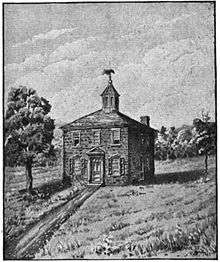1st Ohio General Assembly
The First Ohio General Assembly was the initial meeting of the Ohio state legislature, composed of the Ohio State Senate and the Ohio House of Representatives. It convened in Chillicothe, Ohio, on March 1, 1803, and adjourned April 16, 1803.[1] This General Assembly coincided with the first year of Edward Tiffin's first term as Ohio Governor.
| 1st Ohio General Assembly | |||
|---|---|---|---|
| |||
 Ohio's first statehouse at Chillicothe (1800) | |||
| Overview | |||
| Term | March 1, 1803 – December 4, 1803 | ||
| Ohio Senate | |||
| Members | 14 | ||
| President of the Senate | Nathaniel Massie (D-R) | ||
| Party control | Democratic-Republican Party | ||
| House of Representatives | |||
| Members | 30 | ||
| House Speaker | Michael Baldwin (D-R) | ||
| Party control | Democratic-Republican Party | ||
| Sessions | |||
| |||
Background
Under Ohio's first constitution, State Senators were elected to two year terms. For the first class, half were elected for one year and half for two years. Members of the House were elected for each term. The Constitution was written in November, 1802, and submitted to the U S Congress. Elections for the first session were held in January, 1803. The apportionment of legislative districts was based on the 1802 Ohio Constitution, in section 7 of the Schedule.[1] Subsequent sessions would be elected each October, and meet the first Monday of December.
State Senate
Districts
For the first session, the constitution apportioned four senators for Hamilton County, one senator for Clermont County, one senator for Adams County, two senators for Ross County, one senator for Fairfield County, two senators for Washington County, one senator for Belmont County, two senators for Jefferson County, and one senator for Trumbull County.[1]
Members
| District | Senator[2][3] | Party | notes |
|---|---|---|---|
| Adams | John Beasley | successfully contested by Joseph Darlinton | |
| Belmont | William Vance | ||
| Clermont | William Buchanan | ||
| Fairfield | Robert F. Slaughter | ||
| Hamilton | Francis Dunlavy | Democratic-Republican | |
| Jeremiah Morrow | Democratic-Republican | ||
| John Paul | Democratic-Republican | ||
| Daniel Symmes | Democratic-Republican | ||
| Jefferson | Zenas Kimberly | ||
| Bezaleel Wells | Federalist | ||
| Ross | Abraham Claypool | ||
| Nathaniel Massie | Democratic-Republican | elected Speaker of the Senate[2] | |
| Trumbull | Samuel H. Huntington | Democratic-Republican | |
| Washington | Joseph Buell | Democratic-Republican |
Ohio House of Representatives
Districts
For the first session, the constitution apportioned eight representatives for Hamilton County, two representatives for Clermont County, three representatives for Adams County, four representatives for Ross County, two representatives for Fairfield County, three representatives for Washington County, two representatives for Belmont County, four representatives for Jefferson County, and two representatives for Trumbull County.[1]
Members
| District | Representatives[4][5] | Party | notes |
|---|---|---|---|
| Adams | Thomas Kirker | Democratic-Republican | |
| Joseph Lucas | |||
| William Russell | |||
| Belmont | Joseph Sharp | ||
| Elijah Woods | Democratic-Republican | ||
| Clermont | Amos Ellis | ||
| R. Walter Waring | |||
| Fairfield | David Reece | ||
| William A. Trimble | Democratic-Republican | ||
| Hamilton | Thomas Brown | ||
| James Dunn | |||
| Robert McClure | |||
| William Maxwell | |||
| Thomas McFarland | |||
| Ephraim Kibbey | |||
| William James | |||
| John Bigger | |||
| Jefferson | Thomas Elliott | ||
| Rudolph Bair | Democratic-Republican | ||
| Isaac Meeks | |||
| Zacheus Beatty | |||
| Ross | Michael Baldwin | Democratic-Republican | elected Speaker of the House[6] |
| Robert Culbertson | |||
| William Patton | |||
| Thomas Worthington | Democratic-Republican | ||
| Trumbull | Ephraim Quimby | ||
| Aaron Wheeler | |||
| Washington | William Jackson | ||
| Robert Safford | |||
| Wyllys Silliman | |||
Major events
In joint session, state officers were elected: William Creighton, Jr. as Ohio Secretary of State, William McFarland as Ohio State Treasurer and Thomas Gibson as Ohio State Auditor.[6]
John Smith and Thomas Worthington were elected United States Senators, with no record of vote made.[6]
In joint session, local judges and three Ohio Supreme Court judges, Return Jonathan Meigs, Jr., Samuel H. Huntington, and William Sprigg, were elected.[7]
Major legislation
Eight new counties were erected during this session:[7]
- Butler detached from Hamilton
- Columbiana erected from parts of Jefferson and Washington
- Franklin detached from Ross
- Gallia from Ross
- Greene from parts of Hamilton and Ross
- Montgomery from Hamilton
- Scioto from Adams
- Warren from Hamilton
Existing territorial laws were recognized as in force, if not specifically invalidated.
See also
Notes
- Taylor & Taylor, p. 33.
- Taylor & Taylor, p. 35.
- Gilkey, p. 150.
- Taylor & Taylor, p. 35-36.
- Gilkey, p. 186-187.
- Taylor & Taylor, p. 36.
- Taylor & Taylor, p. 37.
References
- Gilkey, Elliot Howard, ed. (1901). The Ohio Hundred Year Book: a Hand-book of the Public Men and Public Institutions of Ohio ... State of Ohio.
- Taylor, William Alexander; Taylor, Aubrey Clarence (1899). Ohio statesmen and annals of progress: from the year 1788 to the year 1900 ... State of Ohio.
External links
- "Alphabetical list of Members of the General Assembly of Ohio for 127 years - 1803 - 1930". State Library of Ohio. Archived from the original on 2012-04-15.